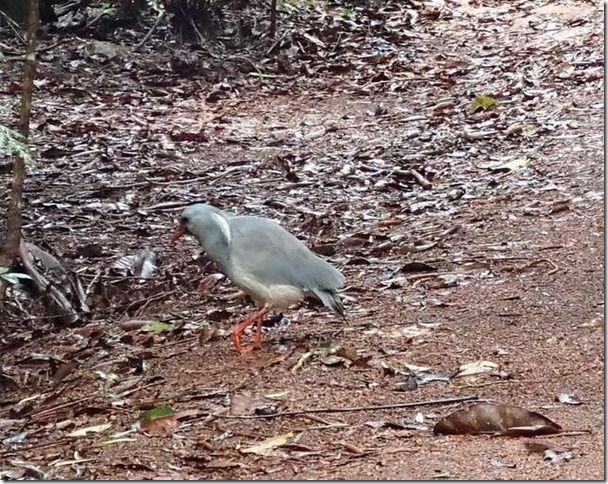The great cagou hunt, and the world's rarest palm tree

VulcanSpirit
Richard & Alison Brunstrom
Sun 29 Jun 2014 11:04
|
The emblem of New Caledonia is the now rare cagou, an endemic flightless
bird. During Vulcan Spirit’s brief stop-over the crew decided to try to seek it
out in the wild so a car was hired and the entire crew set off in search of the
elusive cagou in the Riviere Bleue regional park in the far south of the main
island, Grande Terre.
Cagou Rhynochetos jubatus live in forests, and are entirely carnivorous
searching out food on the forest floor. Here is their environment:
 This area has been extensively logged and most of the habitat severely
degraded but old-growth forest still exists at the valley heads and on some
higher slopes, and now that a large area has protected status as a park things
are improving. The Riviere Bleue is managed for cagou and numbers here are
increasing again slowly. The total population is unknown, but is thought to be
under 1000 birds with about 400 living in the park.
Amazingly, the hunt was successful. The crew hired bicycles (no cars
allowed) in miserable weather with rain on and off. Where there was a sign
saying “Sentier cagou (cagou path) 15min” the team dismounted and were
astonished to find wild cagou wandering around the forest floor near the path.
Some even posed for photographs. One was even found standing right next to a
large display panel telling you in French all about cagou. So here are some
cagou pictures:
  The quality of these photos is not great but they had to be taken in
natural light in a forest so they’re the best we could do.
The origin of these birds is obscure. It’s closest known relative is the
South American sunbittern, but it may also be related to NZ’s extinct adzebills
(NC was once part of ancient Zealandia and is fauna & flora show some
substantial similarities with NZ), so they may have been in NC since it left
Gondwana some 80m years ago. Or not. They have well developed wings but can no
longer fly because they lack the necessary musculature. There was once a larger
lowland species but it didn’t survive the arrival of humans.
Here is the visiting half of the crew of VS en route back to the car at the
end of the successful hunt (note the red soil; this part of NC is composed of
oceanic crust with a very high metal content, especially :
 |